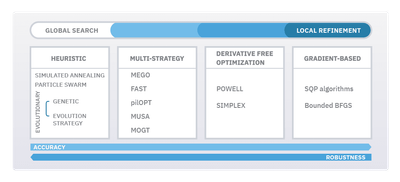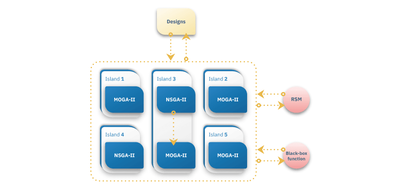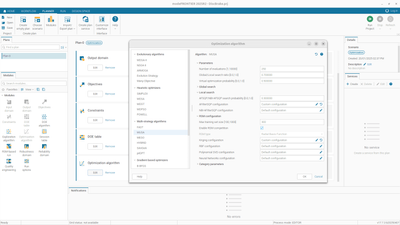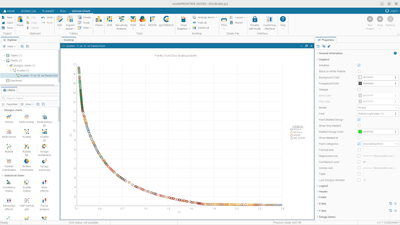Tailored design optimization strategies and transparent results: the power of the MUSA multi-island algorithm
Written by Elisabetta Sergi and Juan Ungredda
30 June 2025

When approaching the design of a new product, understanding both the performance potential and the development timeline is crucial for maintaining a competitive edge. Early insights into these aspects can help you make better/informed decisions and allocate resources efficiently, ensuring that the final product meets market needs efficiently and cost-effectively. Design optimization technology plays a central role in this process. It empowers you to systematically explore countless design solutions and identify those that best meet specified design targets. By leveraging advanced numerical methods, optimization technology enables the exploration of trade-offs between various design parameters, such as weight, strength, efficiency, manufacturability, and cost.
The ability to clearly define the problem — including all relevant parameters, constraints, and objectives — is fundamental to the success of the optimization process. However, one of the biggest challenges in engineering design is choosing the right optimization strategy to tackle a design problem. ESTECO’s numerical technology, integrated within modeFRONTIER software, helps users to define and implement the most suitable optimization strategy tailored to their specific project needs. This is achieved by leveraging optimization algorithms that consider the boundaries of the design space as well as the desired level of accuracy for the final solution.

ESTECO optimization algorithms at glance
The suite of ESTECO optimization algorithms is designed to respond to different design needs and address both discrete and continuous variables to solve single and multi-objective problems. Together with the reliable implementation of traditional methods consolidated by the engineering practice, we offer sophisticated multi-strategy algorithms that multiply the capabilities of single approaches with artificial intelligence (AI). You can combine powerful optimization methods to further reduce the time and effort required to complete the design cycle.
- MEGO: achieves a high converge rate and efficiency in finding the global optimum particularly when performing heavy simulations.
- FAST: leverages response surface models (RSM) performance over the region of most interest in the design space, reaching a high-speed detection of the optimal solutions.
- pilOPT: a multi-strategy, self-adapting hybrid algorithm that combines the advantages of local and global search algorithms while balancing real and RSM-based optimization to search the Pareto front.
- MOGT: effective for improving baseline configurations and handling multi-objective problems where trade-offs between objectives are crucial, with a reduced number of simulations.
- MUSA: adaptively combine various optimization techniques and RSM, improving efficiency and solution quality for complex multi-objective problems.
With the introduction of the new MUSA algorithm in modeFRONTIER, we aim to support expert users who seek granular control and a deeper understanding of the underlying mechanics of algorithmic behavior. MUSA offers a groundbreaking approach to creating custom design optimization strategies by combining diverse traditional metamodeling and optimization techniques. It's designed to efficiently solve single and multi-objective problems with constraints, supporting both continuous and discrete ordered variables.

Musa algorithm integrates a variety of modeFRONTIER’s algorithms (genetic, gradient-based or RSM)
Build your own optimization approach with the MUSA multi-strategy island-based algorithm
At its core, the MUSA algorithm is built on a sophisticated island-based architecture. Imagine your optimization problem being explored by multiple and independent islands, each running distinct algorithms simultaneously. This capability enables you to select and integrate a variety of modeFRONTIER’s algorithms — such as genetic, gradient-based methods, or RSM — into a strategy that's perfectly customized for your specific design challenges. The result is a significant enhancement in the effectiveness and potential of your design optimization efforts.

The MUSA island-based architecture
What makes MUSA a Game-Changer?
MUSA goes beyond conventional optimization, offering a comprehensive suite of features that significantly enhance both the exploration of new design spaces and the precise refinement of promising areas:
- Multithreading: this is a critical feature in computationally intensive environments where time efficiency translates directly to cost savings. The MUSA algorithm architecture is designed from the ground up with multithreading capabilities, allowing you to leverage the full power of your hardware and substantially reduce optimization runtimes.
- Complete customization and control: MUSA gives you complete flexibility to tailor optimization strategies precisely to your project needs. Its core strategic approach enables you to fine-tune the delicate balance between global exploration (looking for new, potentially better regions of the design space) and local exploitation (refining known promising areas).
- Tunable internal optimization algorithms: designed for expert users who require fine-grained control over every aspect of the optimization process. Unlike black-box solutions that restrict user intervention, MUSA exposes and makes all relevant parameters of its internal optimization algorithms fully tunable.
- RSM-based optimization for expensive functions: When working with expensive black-box functions that demand computational expensive and time-consuming simulations, MUSA can leverage RSM-based optimization methodology to drastically cut down evaluation time by building accurate surrogate models. You can define the balance between direct and surrogate evaluations, select specific algorithms (Kriging, Radial Basis Function, Polynomial SVD, and Neural Networks), and choose the relevant parameters for each RSM. MUSA can also automatically select the best-performing RSM from a pool of competing RSMs during the run, based on its performance throughout the optimization process.
- Transparent phases, actionable insights: understanding how an optimization algorithm progresses is vital for fine-tuning and building trust. MUSA provides clearly defined algorithmic phases, along with detailed logs and design categories, offering clear insights into the algorithm's progress and decision-making process.
- Analytical derivatives for speed and precision: When available, analytical derivatives offer invaluable directional information to an optimization algorithm, significantly accelerating convergence and improving precision. MUSA is designed to integrate these derivatives, maximizing both speed and accuracy.

The Musa algorithm configuration in modeFRONTIER
Application scenario: MUSA algorithm for disc brake optimization
To illustrate MUSA's advanced capabilities and core advantages, we’ll examine a common engineering challenge in the automotive industry: disc brake optimization. In this scenario, the primary objectives twofold — first, to minimize the mass of the brake system, which directly impacts vehicle efficiency and material costs; and second, to minimize the stopping time, which is critical for safety and performance.

The disc brake design problem
These competing goals require a multi-objective design optimization approach where the goal is to find a set of optimal trade-offs known as the Pareto front. This set represents the best possible compromise between mass and stopping time, enabling engineers to select a design that balances performance and efficiency that aligns with their priorities. The design involves four key variables:
- Inner radii of the discs.
- Outer radii of the discs.
- Engaging force applied.
- The number of friction surfaces.
In addition to these variables, the optimization must satisfy several critical constraints to ensure that the final designs are not only efficient and high-performing but also physically feasible and safe. Constraints include pressure, temperature and generated torque. By applying MUSA’s island-based, multi-strategy algorithm to this problem, you can tailor each “island” with the most effective optimization technique for specific problem aspects.
For instance, Genetic Algorithms (like MOGA-II or NSGA-II) excel at exploring while RSMs can drastically cut evaluation times for computationally expensive "black-box" constraints by building accurate surrogate models. Beyond customization, MUSA delivers transparent algorithm phases and actionable insights, moving beyond a "black-box" optimization. For the disc brake problem, this means understanding how optimal designs were found — observing which island contributed to specific Pareto front regions and the evolution of the design space. This deep insight into the algorithm's inner workings builds trust and empowers engineers to refine future optimization strategies.

Pareto frontier of the Disc brake problem. Design categories allows for visualizing which algorithms contributed to the generation of the Pareto frontier.
As outlined in this post, the ability to quickly explore and optimize design solutions is a necessity in today’s fast-paced product development landscape. Design optimization technology embedded in the ESTECO’s modeFRONTIER software, empowers engineers to meet this demand. The MUSA algorithm strands out as a game-changer, offering a high level of control and insight into the optimization process. Its unique island-based, multistrategy architecture allows you to craft highly customized optimization approaches, combining various techniques. By providing features such as multithreading, complete customization, RSM-based optimization for expensive functions, and the usage of analytical derivatives, MUSA provides engineers with a methodology to find optimal solutions and to deeply understand the underlying processes, enabling continuous improvements in design strategies. With advanced design optimization algorithms like MUSA, you can make more informed decisions, allocating resources more efficiently and confidently delivering products that meet market needs.
modeFRONTIER is the leading software solution for simulation process automation and design optimization.
Design better products faster
modeFRONTIER is the leading software solution for simulation process automation and design optimization.
Design better products faster
modeFRONTIER is the leading software solution for simulation process automation and design optimization.


